
Ultimate Piston Twin: Diamond DA62
“Why this innovative twin could make inroads in the single-engine market…”Plane & Pilot Article By Robert Goyer
Twin Diamond DA62. I know that other aviation journalists have described the “sleek” and “sexy” look of the new DA62, but that’s not how it strikes me at all. With its long, angular and jutting lines, the DA62 looks to me more like a scorpion than a swallow, and if fate is kinder to Diamond Aircraft with this product introduction, it might just wind up being that kind of silent stalker. The prey, in this case, could be the high-end, high-performance single-engine airplane.
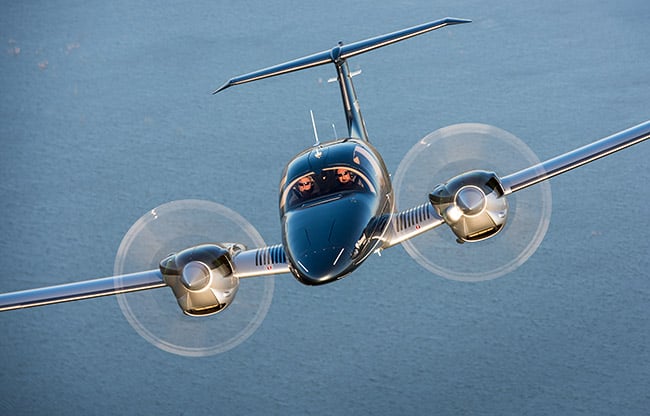
The Diamond DA62 is the only next-generation piston twin. Unlike mature all-metal products from Beechcraft and Piper, the DA62 takes innovative approaches to propulsion, with its economical and fuel-smart Jet-A diesels and materials, including all-carbon-fiber construction.
It’s been a while since the well-heeled personal transportation pilot was tempted to look seriously at twin-engine airplanes when looking to get into a late-model speedster. With the arrival of the DA62, a fast, roomy, utilitarian and technologically capable plane, the choice is there, just as it was 50 years ago when buyers looked with equal interest at Beech Barons and Cessna Centurions. The DA62, in some ways, restarts that conversation because it brings to the table one element that the B58 Baron or Cessna 421 couldn’t: economy.
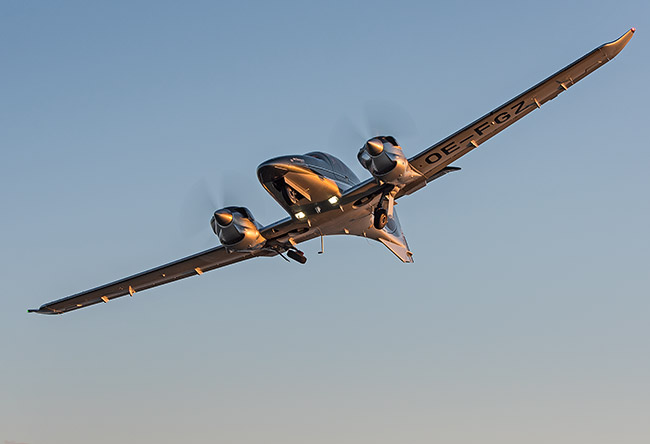
Flying the Diamond DA62 out of San Marcos, Texas.
Rough Ride
Since its inception 20 years ago, Diamond has prided itself on doing things differently, not for the sake of doing them differently, but for the sake of doing them right. Diamond innovated in terms of materials, including carbon fiber, which it used in increasing amounts as its models became more advanced; with crashworthiness; with 26-G seats, seatbelt airbags and a carbon-fiber cage; with quiet flight; with a high-aspect-ratio wing and quiet engine/prop combinations; and, of course, with the engines themselves, helping drive the development of the first modern aviation diesel engine, the Thielert Centurion, and then, when Thielert failed, creating its own company, Austro Engine, to take up the mantle of the aero diesel.
The Diamond twin has a long heritage. The original, the TwinStar, was developed in the early 2000s and earned FAA approval in 2005. The plane was the first Diamond in any number to be powered by a diesel engine, a technology that the company had eyed from the start as making a lot of sense, not only for its primary intended market, Europe, where 100LL is exorbitantly priced, but for the future when regulators might put a stop to the production of the world’s only leaded gasoline. While the Jet-A Thielert engines were very impressive in a number of ways, including consuming a remarkably small amount of fuel per hour (around 4 gph at typical training power levels), they proved prohibitively expensive to maintain. Of chief concern were the gearboxes that turned down the rpms of the engine to a more usable prop speed. The complex mechanical boxes needed to be removed and sent back to the factory in Germany after only a couple hundred hours and at a cost that made 100LL look like a bargain.
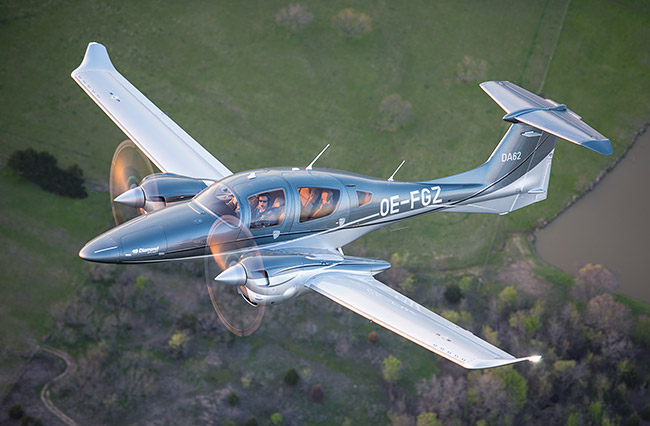
As is universal with Diamond aircraft, the wingspan of the DA62, at nearly 48 feet, is sailplane-like in both length and aspect ratio. The effect is excellent climbing ability and fuel efficiency.
Eventually, Diamond stopped production of the DA42, Thielert entered insolvency (the German equivalent of bankruptcy) amid financial improprieties, and the future looked dark for the TwinStar. Sadly, after Diamond had created its own sibling company to manufacture engines for its diesel birds, the global financial crisis hit and Diamond was thrown for a loop once again.
The good news is that the DA62 looks like it could be the medicine that the doctor ordered to get Diamond back up on its feet again. The DA42, by the way, is back in production with its own Austro engine.
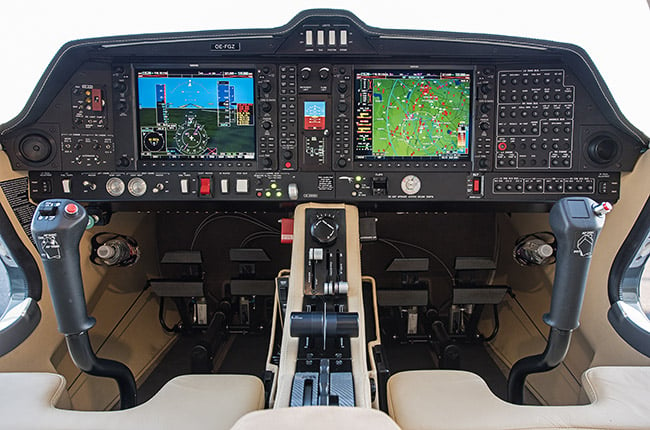
Diamond chose to stick with the G1000 platform, adding a center-mounted Mid-Continent self-powered standby instrument. Another commonality in Diamonds: sticks.
I earned my multi-engine rating in the four-seat DA42 at Europe-American Aviation in Naples, Florida, 10 years ago now, and I remember every moment. The DA42 was, as advertised, a great little twin, but with just 135 hp per side, it was a bit anemic. Its single-engine rate of climb was weak, and the plane’s single-engine handling, while good, took a lot of force. My leg would often give out before the lesson did.
The addition of the 168 hp Austro AE-300-series engines to the DA42, resulting in a new model Diamond called the DA42 NG (for, you guessed it, Next Generation), brought a level of performance that made it not only an improved trainer, but a viable personal transportation platform, too. Still, most of the orders that Diamond got for the DA42 were from flight schools, and for good reason. The savings a busy flight school can realize from the low fuel burn on the DA42’s Austro engines could be enough to justify the cost of the plane.
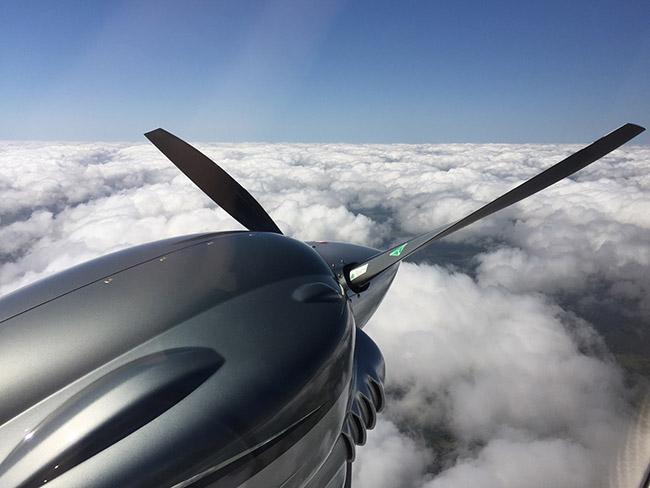
Thanks to a more powerful (read, “larger”) rudder, the DA62 boasts outstanding single-engine flight characteristics, along with impressive single-engine climb: We saw 450 fpm.
Enter DA62
While the DA62 looks like a version of the DA42, it is, if not a clean-sheet airplane, then for all intents and purposes, a brand-new model. Everything about it is different. Its wing is even longer than the already wide wing of the ’42, its tail is taller, its cabin is wider, and its heft, at just over 5,000 pounds max weight, is heftier.
Entry is easier and more substantial a process. There are twin gull-wing doors up front and one in back that allow for easy entry and egress, and the third-row occupants simply have to step in over the middle-row seats, the backs of which fold down for easy in and out for the rearmost passengers.
That’s right, I said, “third row.” The DA62 is not only larger than the ’42, but it seats nearly twice as many people. That’s right, the DA62 seats up to 7 people, with two in the front, three in the middle and two in the back. And the rear seats are usable by adults, unlike some of the compromises you see in some six-seat singles or the tiny middle seat in the ostensibly five-place G5 Cirrus.
They’re usable operationally as much as ergonomically. That is, not only can a grownup fit in the seat, but once they’re in it, the airplane can still take off legally. Angel City Flyers, a Long Beach, California flight school and Diamond dealer, has a cute video demonstrating that it, indeed, can.
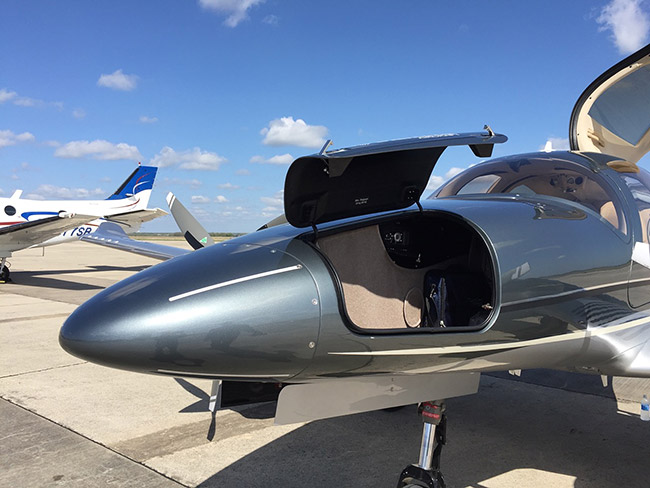
With twin forward luggage lockers and a third-row seating area that will mostly get used as a cargo hold, the DA62 boasts impressive cargo capacity along with a good payload to carry it.
The DA62 has a remarkable useful load of just under 1,600 pounds and a full-fuel payload of right around 1,000 pounds. So you can’t take seven FAA-regulation-sized adults with you; you can take five 170-pounders and still have enough payload for 140 pounds of luggage. You can’t come close to that in an SR22.
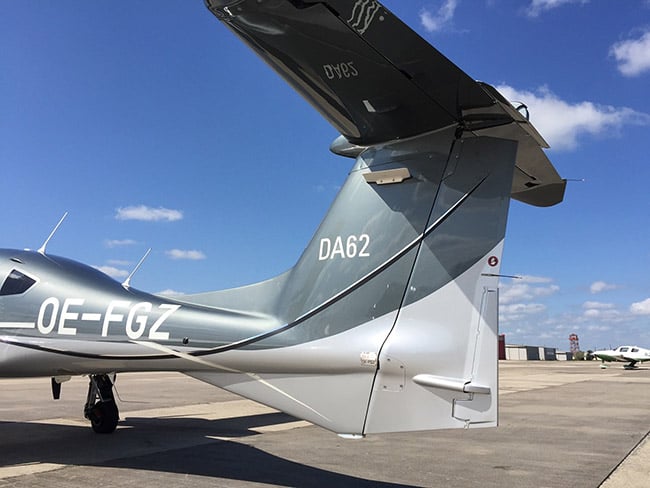
The slick and narrow-fuselage DA62 needed additional side area, and its designers went to town, with a huge vertical fin and sizable ventral, as well.
Here, the matter of efficiency comes to the fore. With the Austro AE-330 engines, the fuel capacity can be lower so that even when you top off the tanks, there’s still enough payload left to carry those people. The DA62 carries 86 gallons of fuel, which seems like less than the 92 gallons the latest SR22 holds, but it’s not. Wait a minute. How is 86 gallons not less than 92 gallons? It’s because Jet-A weighs more than 100LL, so the fuel the DA62 carries weighs around 30 pounds more than that in the wings of the Cirrus.
But let’s remember that there are two engines on the DA62, as opposed to a single engine somewhat intuitively on the Cirrus single-engine model. But because the two Austros in the DA62 burn less fuel (around 12 gph total, which I guess is a lot less fuel) than the one 550-series Continental in the Cirrus (which burns around 16 at an equivalent power setting), the DA62 has a lot more range than the SR22. With a range of 1,283 nm, compared to 853 nm for the SR22, the DA62 has more than 300 nm more range than the Cirrus. For many, many of my missions, that’s the difference between a one-stop and a nonstop trip.
The DA62 is fast, too, around 190 knots at 14,000 feet, where you’ll be going through around 17 gph total. That’s a tad slower than the Cirrus, but not by much. One thing the Cirrus has going for it is the parachute. The DA62 doesn’t have a chute. One thing the DA62 has going for it is a second engine. The SR22 only has one engine. The SR22 comes with optional TKS anti-icing, built-in oxygen, air conditioning and the G1000 avionics system. The DA62 does, too.
In terms of safety utilities, the DA62 is the most advanced Diamond, to date, with ADS-B In/Out, TKS, Garmin’s impressive ESP envelope protection to help prevent loss of control and the best-in-class Garmin GFC 700 autopilot. There’s that second engine I mentioned, too.
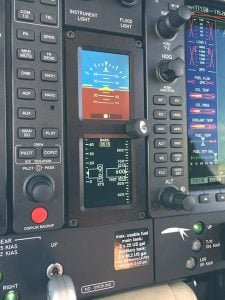
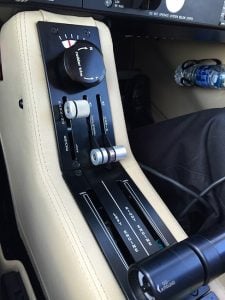
ABOVE, RIGHT: Thanks to the FADEC Austro engines, the DA62 boasts single-lever power for ease of operation and safety, too, due to the system’s auto-feathering capability. ABOVE, LEFT: There’s no keyboard FMS controller, as there is in the Cirrus Perspective cockpit, among others, so you need to reach out to touch the controller directly. Autopilot, audio panel and standby instruments are centrally located for easy access from either side of the cabin.
It’s an impressive package when it comes to user-friendliness, as well. The Austro engines are FADEC, so the starting amounts to two button pushes, and once both mills have come to life, there’s no magneto check (as there are no mags), just an electronic circuit test, which requires the flick of a switch. With FADEC also comes easy power management. The FADEC takes care of all the management, so there are no prop or mixture levers, just two thrust levers, one for each engine.
Flying The DA62
I went flying in the DA62 with Diamond’s Trevor Mustard out of San Marcos, Texas (KHYI), recently, and as has been the case of late, I brought the wind with me. It was howling. Getting into the DA62, thanks to its gull-wing doors, is easy, and even though I was worried about the safety of the doors in the big winds that day, I realized in short order that they’re sturdy enough that it will take a lot more than a breezy Texas day to do them any damage.
Startup, as I said, is dirt-simple. You’ve gotta love FADEC. The push of a big silver button jolts the engine to life, then you repeat for the other side. Test the electronic ignition and you’re good to go. Taxiing is easy. The airplane sits high up, thanks to its long gear legs, and the visibility out of the wall of Plexiglas surrounding you is excellent to begin with.
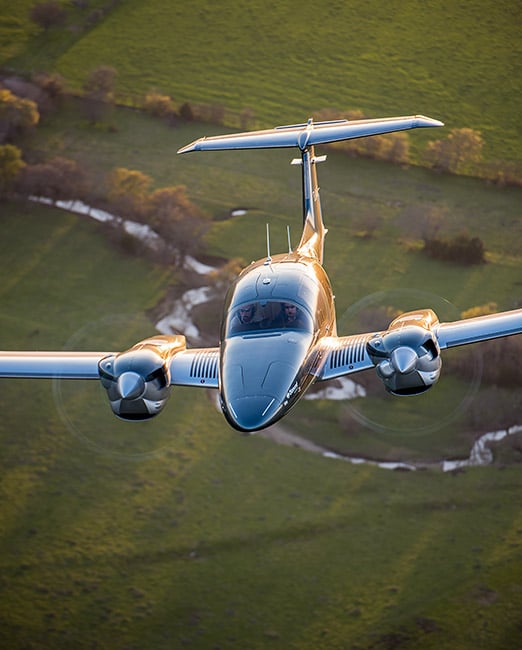
As multi-engine pilots know, there’s nothing especially different about taking off in a twin, except that you do just about everything differently just in case an engine fails. We were lucky, whew, and the takeoff was uneventful, except that we used very little runway thanks to the big wind, and we climbed away, thanks to the big wing and powerful engines, at quite an angle and rate, around 1,200 feet per minute (though we were admittedly pretty light that day; book rate of climb is around 1,000 fpm).
It’s not often that the bigger version of an existing airplane, if that is, indeed, what the DA62 is, flies better than the smaller one, but that’s the case here. The ’62 feels better harmonized than the DA42, which is a good flying airplane, too. The visibility in the DA62 is nothing short of spectacular, and with the availability of air conditioning, pilots have a fighting chance of fending off the dreaded greenhouse effect that most scientists agree contributes to global cockpit warming. The climate control worked great.
We flew a number of maneuvers—steep turns, stalls, slow flight—and there were no surprises, except that the airplane feels much lighter than it actually is. The sailplane-like wing surely helps in that regard.
I was really looking forward to flying the airplane on one engine, so the nice Mr. Mustard talked me through the simple process of shutting down an engine in flight. As soon as you shut it down, the FADEC automatically feathers the prop for you. There’s no chance to feather the wrong prop, another great safety feature. I found that the plane flies much better on one engine than the DA42 does, and that’s surely because of the greater power and giant rudder. With the left engine shut down and around 95 percent power on the right engine, I was able to coax 400 fpm climb out of the airplane at 6,500 feet, and with an Alps-friendly single-engine ceiling of 14,000 feet, the new Diamond has terrific safety margins when operating on a single engine.
Landing the DA62 is about as easy as can be. The trailing link landing gear is forgiving of all but the most dramatic arrivals, and the speeds are very similar to those you’d use for a high-performance single, and with so much glass, it’s a lot easier to see the other traffic than it is in some other planes. In our case, we had the airport to ourselves, well, except for a lot of big birds, including, and this is a Texas first for me, a bald eagle. He avoided us on short final. Though it had been years since I’d landed a Diamond twin, I still managed a couple of very serviceable arrivals even with the gusty conditions, using very little runway in the process.
The Value Proposition
The DA62 would be an easier airplane in which to tackle the multi-engine rating than the DA42, or Seminole, for that matter, though it remains to be seen how much interest the airplane gets from flight schools, as it’s substantially more expensive to buy than the DA42.
The airplane I flew was outfitted with air conditioning, TKS and built-in oxygen, all three of which I’m guessing just about every customer will opt for, bringing the total to around $1.3 million, about $400,000 more than a tricked-out SR22.
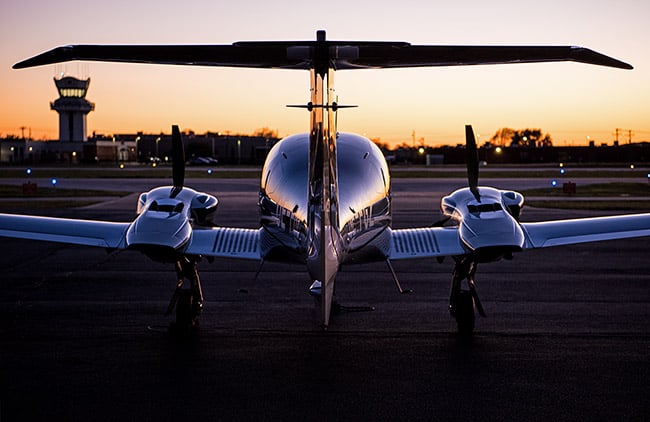
For a million-plus-dollar airplane, you want ramp appeal, and the DA62 has it, with its distinctive, aggressive styling that oozes carbon-fiber cool.
That’s a pretty good upgrade, but at the same time, the DA62 gives pilot-owners the opportunity to fly farther with more payload and the safety of an additional engine. For many potential DA62 buyers, it might come down to one of the oldest arguments in the book, whether it’s safer to fly a twin or a single, in this case, a single with a chute.
While it’s too early to tell if the DA62 will steal away large numbers of potential Cirrus buyers, the new model from Diamond, which in many ways is the most advanced piston twin ever, has surely reinvigorated the conversation.
Read the full Plane & Pilot Article